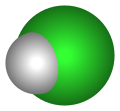Hydrogen halide
Hydrogen halides (or hydrohalic acids) are inorganic compounds that contain a hydrogen atom and a halogen atom. The halogens are fluorine, chlorine, bromine and iodine. Astatine does not make a stable hydrogen halide, so it is not included.
The hydrogen halides are diatomic molecules with no tendency to ionize in the gas phase. Chemists therefore distinguish hydrogen chloride from hydrochloric acid. The former is a gas at room temperature that reacts with water to give the acid. Once the acid has formed, the diatomic molecule can not easily be regenerated.
| compound | formula | structure | model | d(H−X) / pm (gas phase) |
μ / D | Notes |
|---|---|---|---|---|---|---|
| hydrogen fluoride | HF | 91.7 | 1.86 | Highly toxic, weak acid | ||
| hydrogen chloride | HCl |  |
 |
127.4 | 1.11 | Strong acid, most common |
| hydrogen bromide | HBr |  |
 |
141.4 | 0.788 | Strong acid |
| hydrogen iodide | HI |  |
 |
160.9 | 0.382 | Strong acid, reducing agent |

